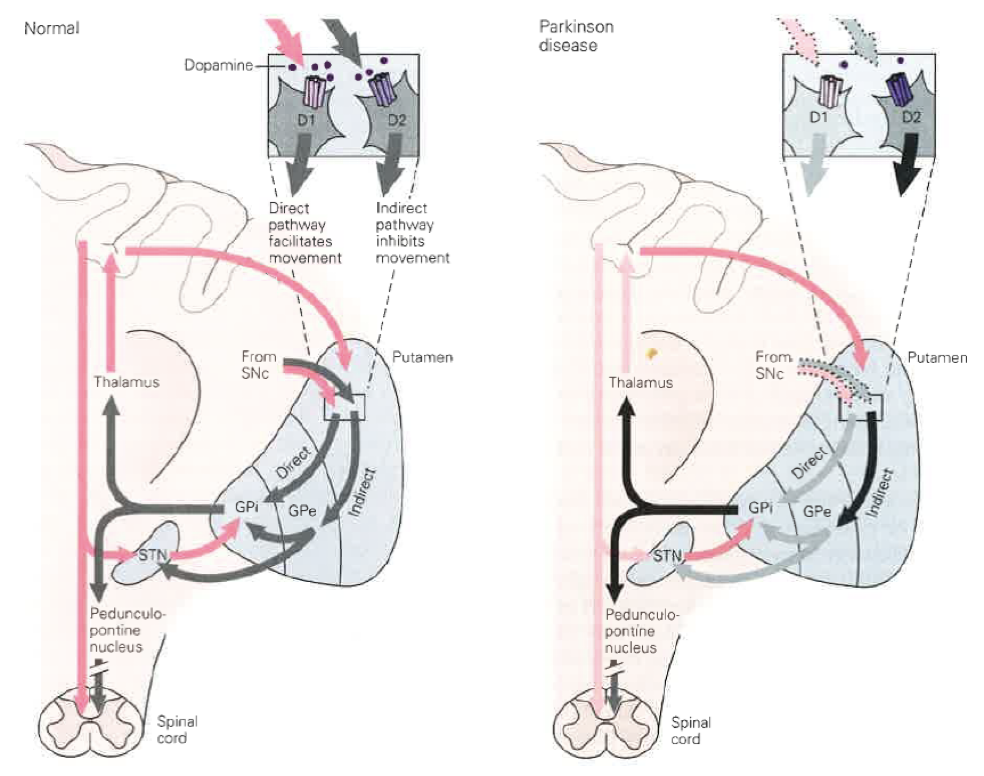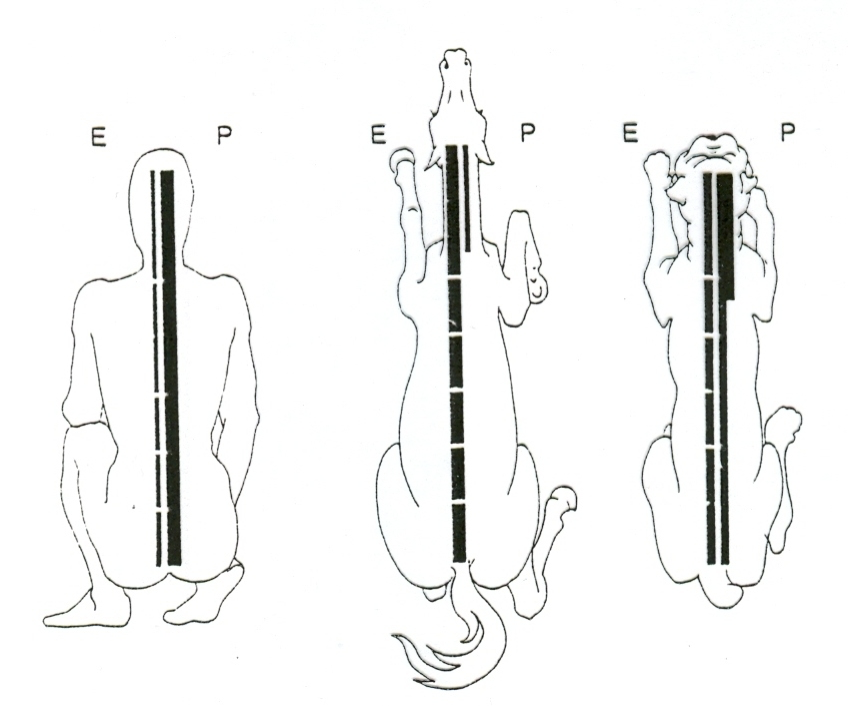Reg. of Motor Control and the Limbic System (Week 2, Mod 8)
1/33
There's no tags or description
Looks like no tags are added yet.
Name | Mastery | Learn | Test | Matching | Spaced |
|---|
No study sessions yet.
34 Terms
What are the 3 major components of the Telencephalon?
1) Cerebral cortex
2) Limbic system
3) Basal ganglia
What are the 4 major components of the Diencephalon?
1) Thalamus
2) Hypothalamus
3) Pituitary gland
4) Mammillary bodies
What is the Rhinencephalon of the brain?
The area of OLFACTORY processing in the brain
Different sizes through species; humans is small, while dog is large
What is the general function of the limbic system?
Is primarily involved in the control of EMOTION, learning, and memory
What are the 6 major divisions of the limbic system?
1) Hippocampus
2) Amygdala
3) Mammillary body
4) Fornix
5) Septum
6) Cingulate cortexes (L and R)
Structures are arranged differently according to species… specific to us as individuals
What is the function of the hippocampus?
Is great for spacial orientation, and memory for an individual’s location within a space
Is also good for LONG TERM MEMORY
Basically spacial awareness, spacial navigation, and memory of being in a place
What are the 3 major structures of the hippocampus? What are the 2 different kinds of hippocampal cells, and what are their functions?
Has two layers:
CA1
CA3
Dentate gyrus fills the space between the two layers
Made of 2 types of cells, each has its own function:
‘Grid’ cells - provide a universal neuronal coordinate system for spatial navigation
‘Place’ cells - activated ONLY when the animal is in a specific place
What are 2 examples of explicit memories? What structure in the brain is responsible for them?
1) Facts
2) Events
The HIPPOCAMPUS is responsible for maintaining these memories
Remember, good for LONG TERM memory
What are 4 examples of implicit memories, and what structures in the brain are responsible for each?
1) Priming - memory due to repetition; i.e. when you repeat a number over and over to memorize it
Neocortex is responsible for this
2) Skill / habits
Facilitated by striatum
3) Conditioning - TWO TYPES
Emotional response - facilitated by AMYGDALA
Skeletal muscle response - facilitated by cerebellum
4) Habituation / sensitization - is a REFLEX, but can be unlearned
Facilitated by SPINAL CORD
What would happen if the hippocampus were to be removed from the brain? Think of what is effected, and what WOULDN’T be affected.
Though the hippocampus is central to long term memory and spacial awareness, it is not responsible for ALL kinds of memory / spacial ability
Without hippocampus, an individual would lose EXPLICIT memory
Facts, events
But IMPLICIT memory would remain intact
Motor memory also remains intact
What is the function of the amygdala?
Is crucial for SENSORY and EMOTIONAL MEMORIES
Often is responsible for the BEHAVIOR of the animal, both innate and learned behavior, based on the animal’s sensory and emotional memories to certain incidents
Forms sensory cues: olfactory, visual, auditorial, pain; ASSOCIATIONS of an animals environment with these senses are formed here
Think A = ASSOCIATION = AMYGDALA
What are the two different brain nuclei in the amygdala?
Basolateral nuclei
Central nucleus
Have slightly different functions depending on species
Describe the species variation of the amygdala… in what ways is it different? In what ways is it the same?
There is HIGH species specific variation when it comes to representation of the environment
You are going to perceive your environment and form different associations with it from Ike
Cues going into our amygdalas will be different
BUT THE LEARNING OF THESE CUES IS THE EXACT SAME ACROSS SPECIES
This is why we can use rats to study human behavior
What is the paraventricular nucleus within the central nucleus of the amygdala?
Is the part of the amygdala that is responsible for STRESS
Associates stress with other senses (i.e. pain → smell, sound, or visual cue)
Is essentially the fight or flight response of our brains
Is the EXACT SAME PATHWAY ACROSS ALL SPECIES
What would happen if there was damage to the amygdala?
Animal (for this example, lets say cat) will try to mate with ANY ANIMAL
Male cat will try to mate with other males, dogs, beavers, etc.
Will also show a LOSS in the FEAR response; will not perceive obvious threats and will wander about without caution
This all essentially shows that the amygdala is CENTRAL in fostering species-specific behaviors (i.e. a cat knowing its not advantageous to try and mate with a dog) and perceiving possible threats
What is a classic example of the amygdala forming a LEARNED association?
Pavlovian response: Rat being shocked when a certain sound is played → eventually learns to fear that sound even if they don’t get shocked later on
What EXACTLY is the fornix, and what is its function?
Is a bundle of nerve fibers along the medial aspects of the two cerebral hemispheres
Has inter-connections with the hippocampi on both sides of the cerebral hemispheres
Is essentially what connects the hippocampus to the MAMMILLARY BODY, relaying info FROM the hippocampus directly to the mammillary body
What would happen if there was damage to the fornix?
Memory impairments / diseases, such as:
Dementia
Caused by demyelination of the nerve fibers in the fornix; results in cognitive dysfunction, short term memory impairments, and long-term memory impairments
Alzheimer’s
Schizophrenia
What is the mammillary body, and what is its function?
The mammillary body is intricately connected with the hippocampus, fornix, amygdala, and midbrain
Primary function: Associated with RECOLLECTIVE memory (LEARNING), but also is involved in emotion and goal-directed behaviors
- Also involved in the formation of NEW memories (anterograde memory)
What would happen in the brain if the mammillary body were damaged? What are some ways it can become damaged?
Trauma, stroke, tumors, and alcoholism cause significant damage to mammillary bodies. The result is anterograde amnesia and reduced motivation
- You know when you black out drunk and can’t remember certain things happening? Yeah, thats cause this guy is gettin damaged
What is the septum, and what is it involved in?
Septum = RAGE
Involved in emotional behaviors, sexual behavior, and aggressive behavior
Also has attention and memory functions
Is simply a MODULATOR of these behaviors, but is not the main driver
Modulates the INTENSITY and PROBABILITY of these behaviors occurring
Receives input from the hippocampus, amygdala, hypothalamus, and midbrain
What would happen if there was damage to the septum?
Lesions to the septum INDUCE RAGE
Individual can no longer gauge / check their own behavior
Exaggerated reactivity to both appropriate AND innocuous stimuli
What is the cingulate cortex, and what is its function?
Is a neural interface between emotion, sensation, and action
Takes our emotional state and turns it into a planned motor response / behavior
Associated with PLANNED behaviors
Is essentially the connection between our LIMBIC and MOTOR systems
What would happen if there was damage to the cingulate cortex?
INDIFFERENCE TO PAIN, and other sensations that have strong emotional connotations
Social indifferences and apathy, eliminates emotional intonation in speech, adn causes personality changes
What exactly is the basal ganglia? What is its function?
The basal ganglia is a set of FOUR NUCLEI that are involved in the control of VOLUNTARY movement. These nuclei are the:
1) Caudate nucleus
2) Putamen
3) Globus pallidus
4) Substantia nigra
Describe the way the basal ganglia communicates with the rest of the brain…
DOES NOT have direct input or output with the spinal cord
Instead, gets input from the CORTEX, and directs output to the MIDBRAIN
Another output pathway happens via the thalamus, which projects to the frontal, premotor, and motor cortices
Has both EXCITATORY and INHIBITORY pathways
What is the main neurotransmitter that drives the function of the basal ganglia? What effect can it have on the basal ganglia depending on the receptor it binds to?
The main neurotransmitter that drives the basal ganglia is DOPAMINE
Acts specifically in the PUTAMEN to drive a direct motor program that facilitates movement
At the same time, INHIBITS the probability of a voluntary behavior
Has opposing effects based on the receptor it binds to (D1 = excitatory, D2 = inhibitory)

What is the direct cause of Parkinson’s disease?
LOSS OF DOPAMINE → results in an INCREASED INHIBITORY OUTPUT of the basal ganglia
The overactivity of this indirect pathway results in hypokinetic disorders (i.e. impaired initiation of movement and REDUCED voluntary movement)
This is why we have the uncontrollable shakiness we see in people with Parkinson’s
The nucleus directly responsible for this increased inhibitory output is the Globus pallidus
Describe the hierarchy of motor control… describe the pathway starting from initial sensory input
Sensory input → limbic system → drives motivation for movement
limbic system → basal ganglia → initiates the movement
basal ganglia → cerebellum → coordinates movement
cerebellum → motor cortex → refines the movement
motor cortex → spinal cord → movement made
What are “pyramidal tracts” in the brain, and what is there function? What, then, are extrapyramidal tracts?
Pyramidal tracts are MOTOR NEURONS that originate in the frontal cortex and terminate in the spinal cord or brainstem
Are essentially DESCENDING pathways that control motor responses
EXTRApyramidal tracts instead originate in the pons and medulla of the midbrain; involved in INVOLUNTARY movement
What is the name of the pyramidal tract that runs down the spine of all animals? What is its function, and how does it vary between species?
Corticospinal tract
Is required for FINE MOVEMENT (recently evolved, new)
Is different across species depending on how much they would need fine movement (ex: a dog will have more dependence on the corticospinal tract than an ungulate)
What are the names of the 4 extra-pyramidal tracts, and what are their functions?
1) Reticulospinal tract -
OLD tract, is responsible for basic instincts (startle reaction), postural, and initiates locomotion
2) Vestibulospinal tract -
Input from vestibular apparatus and cerebellum; acts on extensor muscles
Maintains posture
3) Rubrospinal tract -
Acts mainly on flexors, postural in function
4) Tectospinal tract -
Input from vision and hearing, acts on cervical vertebrae, and orientates head

What would you see in a patient that has damage to the pyramidal tract?
Spasticity and paralysis
What would you see in a patient that has damage to a extra-pyramidal tract?
INVOLUNTARY movements, muscle rigidity, and immobility WITHOUT paralysis